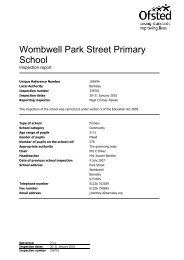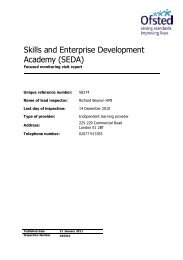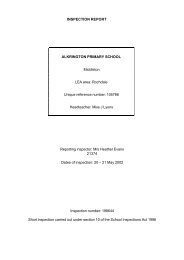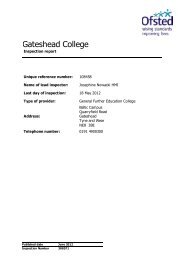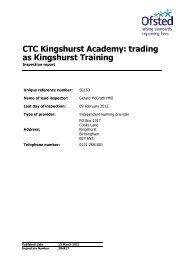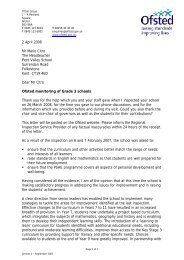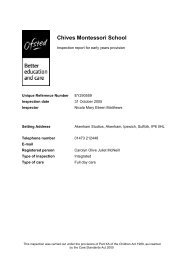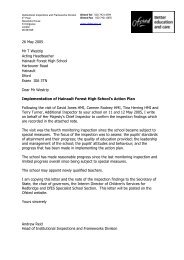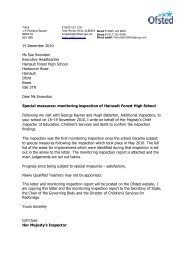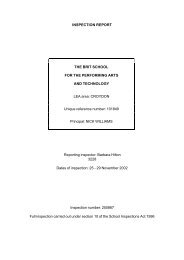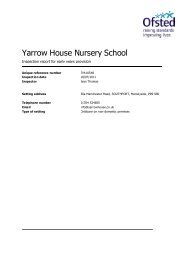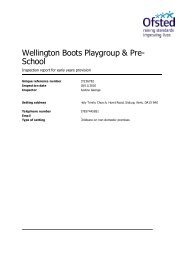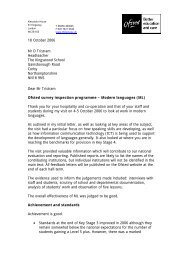20 December 2010 Mr David Baker Headteacher Anthony ... - Ofsted
20 December 2010 Mr David Baker Headteacher Anthony ... - Ofsted
20 December 2010 Mr David Baker Headteacher Anthony ... - Ofsted
You also want an ePaper? Increase the reach of your titles
YUMPU automatically turns print PDFs into web optimized ePapers that Google loves.
Aviation House<br />
125 Kingsway<br />
London<br />
WC2B 6SE<br />
<strong>20</strong> <strong>December</strong> <strong>20</strong>10<br />
<strong>Mr</strong> <strong>David</strong> <strong>Baker</strong><br />
<strong>Headteacher</strong><br />
<strong>Anthony</strong> Gell School<br />
Wood Street<br />
Wirksworth<br />
Matlock<br />
Derbyshire<br />
DE4 4DX<br />
Dear <strong>Mr</strong> <strong>Baker</strong><br />
T 0300 123 1231<br />
F 0<strong>20</strong> 7421 6855<br />
enquiries@ofsted.gov.uk<br />
www.ofsted.gov.uk<br />
<strong>Ofsted</strong> <strong>20</strong>10–11 subject survey inspection programme: design and<br />
technology (D&T) and mathematics<br />
Thank you for your hospitality and cooperation, and that of the staff and<br />
students, during my visit with Stephen Abbott HMI on 6 and 7 <strong>December</strong><br />
<strong>20</strong>10 to look at work in D&T and mathematics.<br />
The visit provided valuable information which will contribute to our national<br />
evaluation and reporting. Published reports are likely to list the names of the<br />
contributing institutions but individual institutions will not be identified in the<br />
main text.<br />
The evidence used to inform the judgements included: interviews with staff<br />
and learners; scrutiny of relevant documentation; analysis of students’ work;<br />
and observation of seven lessons in D&T and nine lessons in mathematics.<br />
Design and technology<br />
The overall effectiveness of D&T is satisfactory.<br />
Achievement in D&T<br />
Pupils’ achievement in D&T is satisfactory.<br />
� Students enter the school with a variety of experiences in D&T and<br />
attainment on entry is slightly below the national average. By the end of<br />
Key Stage 4 students attain below national expectations and too few<br />
students reached the highest grades.
� The legacy of low achievement is steadily being addressed. Students are<br />
proud of their work and achieve a high quality of finish in products that<br />
they have made. Their work shows satisfactory progress. The majority of<br />
students know the level or grade that they are aiming for, but they are not<br />
always clear about what they need to do to improve their current work.<br />
Lower and middle attaining students are not always able to explain their<br />
ideas well. Sixth form students are clear about how to improve their work<br />
and apply this well. Their use of models enables them to develop, explain<br />
and test their ideas effectively.<br />
Quality of teaching of D&T<br />
The quality of teaching of D&T is satisfactory.<br />
� Teachers use their good subject knowledge well to interest students in<br />
work in D&T. Practical activities are emphasised and students’ capabilities<br />
in making are well developed. Students’ understanding of the importance<br />
of how products are designed is not as well developed. They are<br />
enthusiastic and rightly proud of their work. They explained how much<br />
they liked D&T and how well teachers help and support them.<br />
� The impact of assessment practice is inconsistent. Teachers always explain<br />
learning objectives. In the best lessons teachers have begun to use<br />
students’ self- and peer-assessment effectively to share assessment<br />
criteria and this approach promotes good learning. Too often teachers do<br />
not plan work that challenges students to achieve more ambitious targets<br />
or takes sufficient account of students’ different starting points. Teachers<br />
miss opportunities to develop students’ confidence in using technical<br />
language and talking about their work in order to improve their written<br />
explanations. Thus, high expectations for literacy are not promoted<br />
consistently. In less effective lessons opportunities were missed to deepen<br />
students’ understanding of their learning by probing their responses.<br />
Behaviour is good in all lessons, particularly as students move around<br />
activities.<br />
Quality of the curriculum in D&T<br />
The quality of the curriculum in D&T is satisfactory with good features.<br />
� A broad and balanced curriculum is provided at Key Stage 3. Projects such<br />
as the air buggy and lamps are chosen well to interest both boys and girls.<br />
They provide a satisfactory base for the next key stage. Developments in<br />
the curriculum at Key Stage 4, in response to students’ demands, have<br />
begun to attract greater numbers of higher attaining students. Increased<br />
opportunities are provided for vocational courses such as catering and<br />
hospitality, which provide a curriculum more tailored to students’ interests<br />
and meet their learning needs. Cross-curricular links are well established.
These increasingly allow students to apply their knowledge of science and<br />
mathematics well. A rich variety of extra-curricular activities enhances the<br />
students’ experience of D&T and promotes higher standards of work.<br />
Effectiveness of leadership and management in D&T<br />
Leadership and management in D&T are satisfactory.<br />
� The subject leader has a passion and vision for the department which is<br />
shared by his team. They work very effectively together. They have tried<br />
to develop a wide variety of initiatives but the impact of these has been<br />
diluted because there are too many for a small department to implement<br />
effectively.<br />
� The subject leader understands the department’s strengths and<br />
weaknesses and this underpins development planning. They use<br />
collaboration with local schools well to share expertise and promote good<br />
practice. This is beginning to improve the department’s work and its use of<br />
assessment to promote students’ greater independence in their work.<br />
� The department tracks students’ progress carefully and this is used to<br />
identify those students who are under-performing and to ensure that they<br />
have carefully matched interventions. They are beginning to identify those<br />
students who are exceeding their targets and ensure that they are<br />
challenged appropriately.<br />
Areas for improvement, which we discussed, include:<br />
� ensure that all groups of students make satisfactory or better progress by<br />
improving the consistency of teachers’ use of assessment to develop<br />
students’ designing capabilities, and thus enable them to achieve higher<br />
grades<br />
� ensure that teachers plan opportunities to develop students’ skills in using<br />
technical language when talking about their work and to improve the<br />
quality of their writing.
Mathematics<br />
The overall effectiveness of mathematics is satisfactory.<br />
Achievement in mathematics<br />
Achievement in mathematics is satisfactory.<br />
� Attainment in mathematics has improved steadily over the last four years.<br />
The proportion of students gaining grades A* to C is now above average,<br />
though when results at all grades are taken into consideration, they are<br />
still marginally below average. At A level there has been an improving<br />
trend in recent years and results are above average.<br />
� Students’ progress in lessons is currently satisfactory in the main school<br />
and good in the sixth form. Students’ progress in the mixed ability Year 7<br />
and 8 classes is uneven, for the reasons explained in the teaching and<br />
curriculum sections. Sixth-form students showed good understanding, but<br />
a few were too casual with their graph-sketching and written proofs.<br />
� Students learn appropriate mathematical methods and develop their<br />
competence by working through plenty of exercises, albeit of a mainly<br />
routine nature. They generally understand the methods they are shown,<br />
but are less confident in developing their own solutions or explaining their<br />
reasoning. Many are rather passive in lessons. Some lower attaining<br />
students find it difficult to put their understanding into words.<br />
� Learning is reinforced by strong revision and intervention programmes.<br />
Students have access to a web-based revision package when they need to<br />
improve in a particular area of mathematics. They also appreciate the<br />
extra support provided by their teachers outside lessons.<br />
Quality of teaching of mathematics<br />
The quality of teaching of mathematics is satisfactory.<br />
� The predominant teaching style is one of exposition and practise of the<br />
demonstrated method. Problem-solving approaches, where students are<br />
challenged to use their existing knowledge to devise their own methods,<br />
are less frequent. Consequently, students do not develop strong enough<br />
independent learning skills in mathematics.<br />
� Teaching was good in five of the nine lessons observed and satisfactory in<br />
the remainder. In an effective sixth-form lesson, the teacher encouraged<br />
students to be self-reliant, think for themselves and refer to their own<br />
notes where necessary. Group work promoted discussion among students.<br />
� Most lessons feature a well-crafted exposition from the teacher. Ideas are<br />
developed in a logical order and methods carefully explained. In the best<br />
lessons, the teacher’s input is delivered in brief, well-focused chunks,<br />
often supported by visual aids. Students are then set exercises to help
them consolidate their learning. This approach is more effective for classes<br />
that are set by ability. In mixed-ability classes, the teaching does not take<br />
enough account of students’ different starting points.<br />
� Some teachers assess students’ understanding well during the lesson and<br />
address the issues that arise. Other teachers take most answers from<br />
volunteers without checking that others understand, which is less<br />
effective. When students are working individually or in groups, teachers<br />
circulate to check on their progress and to give support where necessary.<br />
In the best cases, the teacher intervenes by guiding the students to think<br />
for themselves, but occasionally this support is too directive, with the<br />
teacher doing much of the talking.<br />
� Although tests and homework assignments are marked, the quality and<br />
quantity of class-work marking are too variable. Although some students<br />
get regular feedback on their class work and the opportunity to check all<br />
their answers, others have many unchecked answers. Some class work<br />
books have not been marked at all by the teacher.<br />
Quality of the mathematics curriculum<br />
The quality of the mathematics curriculum is satisfactory.<br />
� The school is committed to an inclusive approach in which all students are<br />
entered for an appropriate mathematics qualification. Extra resources are<br />
deployed in Year 11 to maximise students’ chances of success. Some<br />
students have extra mathematics lessons and one fewer optional subject.<br />
� Enrichment for the most able students includes regular involvement in the<br />
various UK School Mathematics Challenges. Teachers also give up free<br />
time to maintain a Further Mathematics option in the sixth form. This has<br />
enabled a recent student to win a place at Oxford University.<br />
� Schemes of work indicate the learning objectives for each year and include<br />
links to text books, interactive-whiteboard presentations and other<br />
resources. There are suggestions for investigations and rich mathematical<br />
tasks to develop functional skills. However, the schemes do not provide a<br />
progressive development of skills in using and applying mathematics.<br />
� The school is in the process of adapting the schemes of work to reflect<br />
recent changes in examination specifications. Those for Years 9 to 11<br />
provide a satisfactory basis for lesson planning because they are matched<br />
to students’ prior attainment. In contrast, the schemes for Years 7 and 8<br />
do not. There is no guidance about which learning objectives to prioritise<br />
for students with different levels of prior attainment. Furthermore, not<br />
enough learning objectives are relevant to the lowest attaining students.
Effectiveness of leadership and management of mathematics<br />
The effectiveness of the leadership and management of mathematics is<br />
satisfactory.<br />
� The head of department has established a strong team spirit and an ethos<br />
in which teachers expect to talk regularly about teaching and learning to<br />
share good practice. A strategic decision to provide a graduate trainee<br />
place each year has contributed to professional development for all staff.<br />
Links with the senior leadership team are strong.<br />
� The department benefits from some well-focused monitoring and<br />
evaluation, such as the recent whole-school ‘learning improvement cycle’<br />
to review provision for lower attaining students in Year 9. Lesson<br />
observation and work scrutiny are undertaken from time to time.<br />
However, this has not secured consistency in marking.<br />
� Departmental documentation is well organised and students’ progress is<br />
tracked carefully. Information from the assessment programme is used to<br />
identify students who need extra support to meet their targets.<br />
� The school uses two main performance indicators to measure its success<br />
in securing improvements in GCSE mathematics. These are: the proportion<br />
of students gaining grade C or better; and the proportion of students<br />
meeting the national target for expected progress. The rising trends in<br />
these indicators demonstrate the department’s capacity for improvement.<br />
However, less attention has been paid to value-added measures based on<br />
the average GCSE points score for all students and for specific groups,<br />
which give a more precise measure of improvement.<br />
Areas for improvement, which we discussed, include:<br />
� revising the schemes of work in order to provide<br />
- an appropriate set of learning objectives for each level of prior<br />
attainment in Years 7 and 8<br />
- a suitable progression of learning objectives from the ‘using and<br />
applying mathematics’ attainment target, for all year groups<br />
� increasing the impact of leadership and management by<br />
- widening the range of performance measures, to include those based<br />
on the average performance of all students in a group<br />
- increasing the regularity of work scrutiny, for example to ensure<br />
consistency in marking<br />
- introducing mathematics-specific ‘learning improvement cycles’, for<br />
example to enhance teachers’ skills in assessing students’<br />
understanding and developing their independent learning skills.
I hope that these observations are useful as you continue to develop D&T and<br />
mathematics in the school.<br />
As I explained previously, a copy of this letter will be published on the <strong>Ofsted</strong><br />
website. It may be used to inform decisions about any future inspection.<br />
Except in the case of academies, a copy of this letter is also being sent to<br />
your local authority.<br />
Yours sincerely<br />
Michelle Parker<br />
Her Majesty’s Inspector



